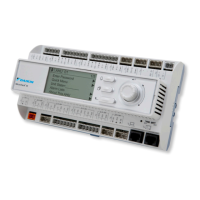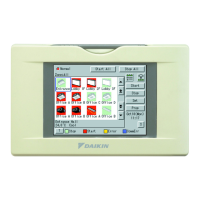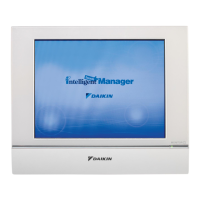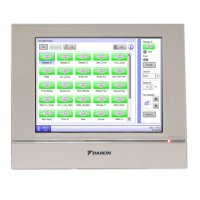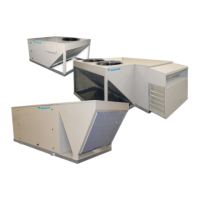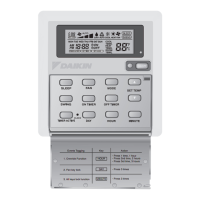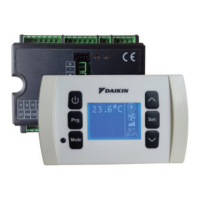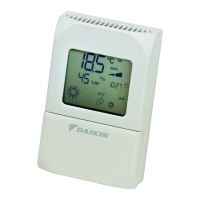• The Occ Mode entry on the keypad is set to Tenant
Override. After the Tenant Override Timer is set, the
Occ Mode entry on the keypad reverts to auto after a 2
second time delay
• The Occ Mode entry on the keypad is set to Auto or
Unocc, and a manual network occupancy command is
set to Bypass. After the Tenant Override Timer is set, the
network occupancy command reverts to Auto
Subsequent presses on the button, setting of the keypad
occupancy entry to Tenant Override again, or setting of the
network occupancy command to Bypass again resets the
Tenant Override Timer to the Local Tenant Override Time.
The TOTime entry on the keypad can also be manually set to a
non-zero value. In this case the value begins timing down from
the edited value.
Tenant Override Operation may be terminated by manually
setting the Tenant Override parameter on the keypad to zero or
by disabling the unit.
Determining Occupancy Mode
Occ Mode is an adjustable item which sets the unit for manual
occupied, unoccupied, tenant override or automatic operation.
Occ
When Occ Mode is set to “Occ,” the unit is manually placed in
the occupied mode of operation.
Unocc
When Occ Mode is set to “Unocc,” the unit is manually placed
in the unoccupied mode of operation.
TntOvrd
When Occ Mode is set to “TntOvrd,” the unit is manually
placed in the tenant override mode of operation.
NOTE: Once tenant override operation is activated the
parameter automatically reverts back to “Auto.”
Auto
When Occ Mode is set to “Auto” the automatically changes
between occupied, unoccupied and tenant override operation.
Determining Occupancy Source
When the Occupancy parameter indicates Occ, the occupancy
source is set to one of the following values to indicate the
function responsible for placing the unit into the occupied mode
of operation.
None The Occ Src= parameter indicates “None” when the
Occupancy= parameter indicates “Unocc” or “Tnt Ovrd.”
NetSchedule The Occ Src= parameter indicates “Net Schd”
when the Occupancy= parameter indicates “Occ” due to a
network schedule indicating an occupied period.
For Example: If the D3 gateway ON/OFF signal is ON, then,
the OccSrc indicates “NetSchd”.
IntSchedule The Occ Src= parameter indicates “Int Sched”
when the Occupancy= parameter indicates “Occ” due to the
unit internal schedule.
OneEventSchedule The Occ Src= parameter indicates “Int
Sched” when the Occupancy= parameter indicates “Occ” due
to the unit one event schedule.
RemoteSwitch The Occ Src= parameter indicates “Remote
Sw” when the Occupancy= parameter indicates “Occ” due to
a eld supplied external time clock or a tenant override switch
signal in the form of a set of dry contacts is closed across
terminals 101 and102 on the unit eld terminal block TB2.
OccManCmd The Occ Src= parameter indicates
“OccManCmd” when OccMode is set to Auto and the network
manual occupancy command is set to Occupied.
OccMode The Occ Src= parameter indicates “Occ Mode”
when the Occupancy= parameter indicates “Occ” due to the
Occupancy Mode being manually set to “Occ.”
TStatTO The Occ Src= parameter indicates “TStatTO” when
the Occupancy= parameter indicates “TntOvrd” due to the
tenant override button on the zone thermostat being pushed.
The button must be held for at least 1 second but not more
than 10 seconds.
ManTO The TntOvrd Src= parameter indicates “ManTO” when
the Occupancy= parameter indicates “Occ” due to the being
manually set via the keypad/display. When the Tenant Override
Timer is set to a non-zero value, the unit starts and runs in the
tenant override mode regardless of any scheduling features.
The unit stops when the timer expires. The Tenant Override
Timer can be set from 0-300 minutes.
operator’s guIde
www.DaikinApplied.com 95 OM 1141-3 • MICROTECH UNIT CONTROLLER
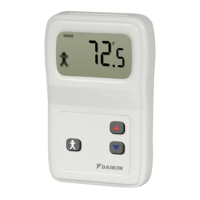
